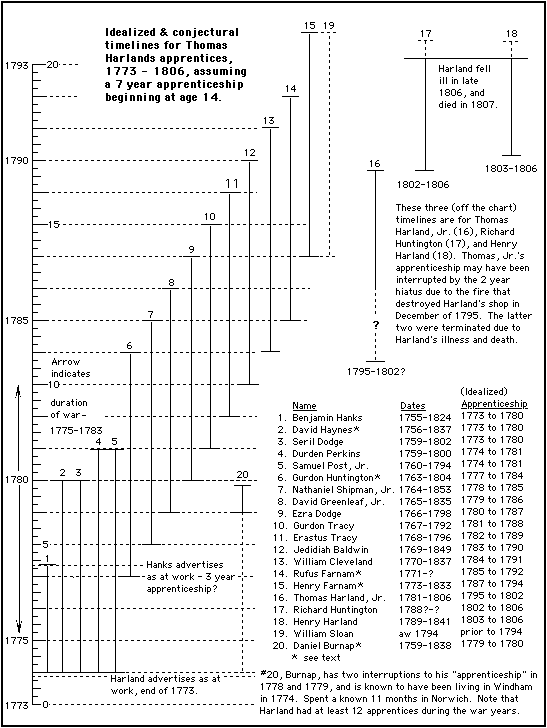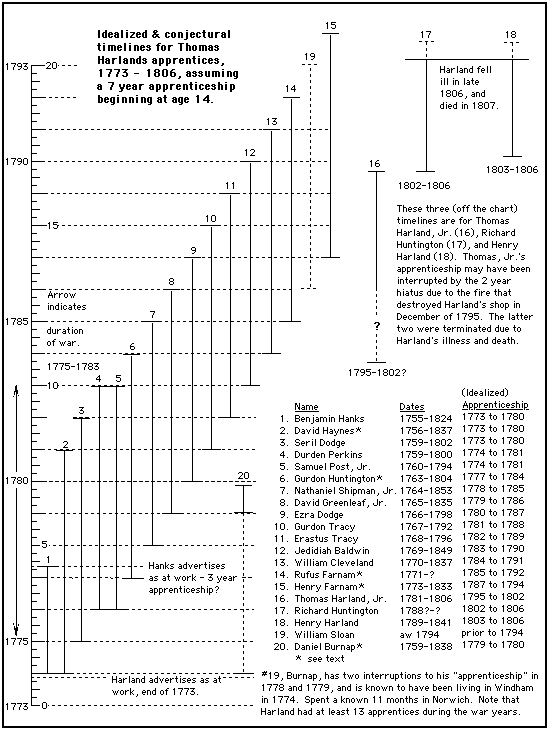Curiously enough, Mr. Willard does not include in this list Harland's two sons, Thomas, Jr., and Henry, although the text of his article mentions that they both apprenticed with their father. Phillip Zea also lists "possibly Benjamin Hanks, David Haynes, and Gurdon Tracy." The probability of Hanks and Haynes is corroborated by Flynt and Fales, but they do not mention Gurdon Tracy as a possible apprentice.
Because Harland is known to have advertised for "a boy of 13 or 14", the idealized dates of apprenticeships, using the latter number, are listed in the third column above, and are used to construct the timelines in the chart in Figure 1. For simplicity's sake, the assumption is made that the apprenticeship commenced at the beginning of the calendar year, and ended when the traditional 7 year term was complete. The chart illustrates the temporal relationships of the various people involved with Thomas Harland---but remember---it's all a guess, albeit an educated guess.
2

Figure 1. A speculative reconstruction of the dates of the terms of those who served an apprenticeship with Thomas Harland.
2
Reality vs. Speculation
Let's compare the speculation with the known reality, and see just how close we can get by making a scientifically wild-eyed guess.
1. First, Benjamin Hanks, born 1775. Ideally, he would have apprenticed at age 14, in 1769. However, Harland did not (to our knowledge) begin working until December of 1773. Therefore, Hanks could not have apprenticed until at least 1774, and his term should have run to 1781. But we find Hanks advertising as a watch- and clockmaker and a goldsmith in Windham in 1777. That's a mere three years of apprenticeship with Harland, regardless that he was 19 years old in 1774. So much for that attempt at idealization---but he did serve as a drummer in the Revolutionary War. He looks like an anomaly in that he doesn't appear to even come close to fitting in---but Jesse Coleman somehow managed to track down Hanks' son---which son confirmed Hanks' apprenticeship with Harland.
2. Chronologically, Seril Dodge would have finished his term in 1781. We find him listed as at work in Providence, Rhode Island, in 1784. Error is +3 years.
3. We find Samuel Post, Jr. at work in 1783, just two years after the "ideal" date. Error is + 2 years.
4. Although there is some question as to whether Gurdon Huntington apprenticed with Harland, he advertised as a maker in 1784. Spot on.
5. An account book belonging to Nathaniel Shipman, Jr. indicates that he was making horological items for Harland in 1785. Spot on.
6. David Greenleaf, Jr., married in 1787 and settled in Hartford Connecticut, advertising as a silversmith and clockmaker. Error is + 1 year.
7. Daniel Burnap will be discussed later, but he is another anomaly.
8. Ezra Dodge advertised as a clock- and watchmaker in 1787. Spot on.
9. Gurdon Tracy advertised as a silversmith in 1787, but there is some question as to whether he apprenticed with Harland. Error is - 1 year.
10. Erastus Tracy advertised in 1790. Error is + 1 year.
11. Jedidiah Baldwin's apprenticeship ended in 1791---he married in April of that year. Spot on.
12. William Cleveland went into partnership with John Trott in 1792. Error is + 1 year.
13. Rufus Farnam advertised in Boston in 1796. Flynt & Fales think that he apprenticed with Joseph Carpenter in Norwich. Error is + 4 years.
14. Henry Farnam was listed as a goldsmith in Boston, MA, in 1798. Again, Flynt & Fales think that he apprenticed with Joseph Carpenter in Norwich. Error is + 4 years.
15. There is little information on William Sloan, only a 1794 advertisement that mentions his apprenticeship with Harland, and that he made watches, clocks, and silver items. No conclusions.
16. Richard Huntington's apprenticeship began in October of 1802, but was cut short by Harland's illness in the winter of 1806 and his death in March of 1807. Chris Bailey wrote that the boy's father "made a claim of $100.00 against Harland's estate." He was awarded $35.00. and Richard went on to work as a partner in the firm of Huntington & Packard in Springfield, MA, and advertised in 1811. Inconclusive.
3
Regardless that no one lists Harland's sons, Thomas Jr., and Henry, as apprentices, they did work in their father's shop. Thomas Jr.'s term would likely have been interrupted by the 1795 fire that destroyed his father's shop, and Henry's would have ended with his father's 1806 illness. Henry attempted to keep his father's business going after his death, but was rather unsuccessful. Zea, as I mentioned, also lists a David Haynes (1756-1837) as a possible apprentice, a view shared by Flynt & Fales. Haynes' idealized term would have run from 1774 to 1781. A 1781 deed recorded in Springfield, MA, lists him as a goldsmith. Spot on.
Flynt & Fales also list a Durden Perkins (1759-1800) as an apprentice to Harland. His idealized apprenticeship would have run from 1774 to 1781; Flynt & Fales mention an advertisement in 1782, J. Carter Harris lists an 18 June, 1782 advertisement. Perkins is also mentioned as a fifer in the Revolutionary War, and another advertisement on 4 October, 1785 states he "has returned," no doubt from his war duties. Regardless, the error is + 1 year.
That would make a total of 20 apprentices over nearly a 30 year span. In comparing the known at-work dates with the idealized dates, there is one real anomaly ‹Burnap.
More on Burnap later. Five are dead on, 5 are ± 1 year, 2 are ± 2 years, 1 is ± 3 years, 2 are ± 4 years (the Farnums, who may not have been Harland's apprentices). 2 are pretty much unknowns---William Sloan, of whom very little is recorded, and Richard Huntington, with his interrupted apprenticeship. It must be remembered that in all cases, we don't know exactly when the term of indenture began, nor what the apprentice's age was. This may well account for some of the 1 to 3 year variances from the speculative "norm." In view of Hanks' later accomplishments in life, it is possible that he was a very quick study, or that he had begun an apprenticeship with a different master, and moved over to Harland for the last three or four years of his term. That he advertised initially as a goldsmith suggests that clocks weren't his primary interest, but he certainly did a great deal in clockmaking in later years.
I said this was all speculative. But take another look at this version of the original chart. If we move Seril Dodge's apprenticeship up one year from 1774 to 1775; move Post's apprenticeship up two years (both of these changes are well within the realm of possibility); move William Sloan's apprenticeship down (we have no information on this man at all) one year, from 1787 to 1786, and rearrange the indicators for Sloan and Henry Farnam, the chart acquires a rather interesting look. And the changes are well within the realm of possibility. Harland may well have taken on one new apprentice each year between 1774 and 1787. The above is sheer wild-eyed unsubstantiated speculation, but somehow, it seems to fit---except for Burnap. (Fiddle the facts until they fit---the researcher's dream!)
4
Figure 2. The chart of Figure 1, with a few adjustments relating to various apprenticeship timelines. The text just above goes into some detail on the adjustments.
Daniel Burnap just doesn't fit in. His only known residence in Norwich, and attendance under the tutelage of Harland lasted a mere 11 months. Burnap wrote (in a remaining fragment of his [probable] first Record Book) that on:"Tuesday, December ye 9th AD 1777. Then I began to keep school att Easthaddam. I was then in ye 19th Year of my Age"
with a repetition of that statement for:
"November ye 10th, AD 1778. Then I began to keep school att Easthaddam. I was then in ye 20th Year of my Age"
and then:
"June ye 1st, AD 1779. Then I went to live at Windham, and Returned on Monday ye 5th day of July."
He later wrote that on:
"Wednesday, September ye 5th AD 1779. Then I went to live at Norwich."
and:
"Norwich, September ye 8th AD 1779. Then I began to work with Mr. Harland at clock making..." The last of the entries reads:
"Thursday, July ye 7th, AD 1780. Then I went to work with Mr. J. Fairchild at Windsor."
Over the years, a lot of paper and ink has been devoted to Burnap---in my humble opinion, it's been a waste of both---in establishing that he apprenticed with Harland, etc., etc. For a further discussion of this question of Burnap's alleged apprenticeship, go to:
Further studies on Clockmakers of the Northeast: Daniel Burnap, Thomas Harland, & the Suffield Tower Clock
Return to Page Three of the late Donn Haven Lathrop's three main pages.
Compare Donn's original version of this page if it still exists.
To comment on this page, please
